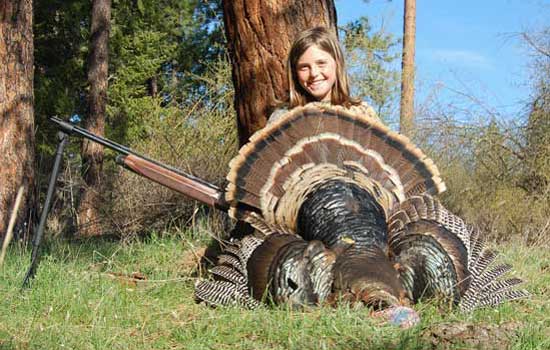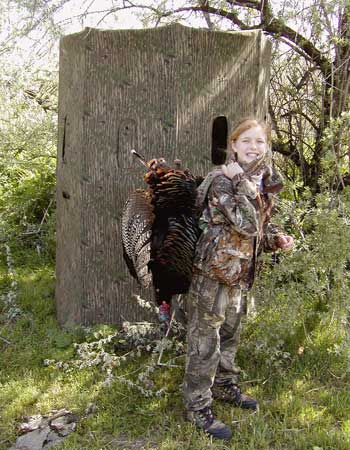2016 Turkey Season Forecast
Turkeys are found throughout the Panhandle Region, except in the mountainous units 7 and 9. Turkey hunting was very good in 2015 in the Panhandle, which was expected after three mild winters. Nest success in 2015 was good due to a warm, dry spring that produced abundant young birds.
The 2015-16 winter had near-normal snowpack, but lower-elevation areas experienced milder-than-normal conditions, which should allow for high carryover so turkeys should be plentiful for the spring.
Except for units 7 and 9, the entire Panhandle Region is open to general spring turkey hunting.
Good hunting opportunities can be found on public land adjacent to private land in lower elevations, especially in units 1, 2, 3 and 5. Obtaining permission from private landowners is a good option for finding turkey hunting spots. Many private landowners will provide access because they want turkey flocks reduced on their lands.
Turkeys are found throughout the forested portions of the region with the highest concentrations:
- Adjacent to the Clearwater River drainage up to the Lochsa and Selway rivers.
- The Snake River drainage up to the Salmon River, and lower Salmon River to White Bird.
- The Dworshak Reservoir area.
Good opportunities for turkey hunting are also found on Fish and Game’s Craig Mountain Wildlife Management Area south of Lewiston, as well as state and federal land, private agriculture land and corporate timber land.
Turkey production in the past three years has been near the long-term average in the Clearwater Region, resulting in numbers that should provide hunting success consistent with recent years.
Mild conditions during the past few winters have resulted in good survival into spring and also serve to aid in allowing hunter access to higher elevation areas when compared to conditions prevalent on many season openers.
This winter brought more snow, but mild temperatures in late February and early March created spring-like conditions in many places. Overall, winter weather seemed manageable for turkeys, and most birds should carry through to the hunting season if mild, warm weather continues at lower elevations.
Hunts in units 22, 31, 32 and 32A were restructured for 2016 to reflect growing turkey populations in portions of 22 and 31. Details can be found in the 2016-17 rules booklet.
More opportunity was also provided during the spring turkey hunt by splitting the regular Unit 38 controlled hunt into two hunts similar to the Unit 38 controlled, youth-only spring turkey hunt.
Turkey hunting opportunities in the Southwest Region by opportunity type include:
- Unit 38 provides quality turkey hunting through controlled hunts, but the 2016 deadline for the drawing has already past.
- Units 22, 23, and 31 have abundant turkey flocks and are dominated by private farm land in the valleys, with public lands at higher elevations.
- Units 32 and 32A provide additional opportunity with private land and public hunting areas.
- Units 33 and 39 provide some hunting opportunities, particularly in the lower elevation private land and adjacent public forest; however, turkey populations have declined in the last decade.
Access to high-elevation hunting areas is variable from year to year depending on snow pack and spring temperatures. However, lower elevations are already opening up, so there should be good access to most or all lower and mid-elevation ranges.
Turkey hunting is limited to controlled hunts in the Magic Valley, and tags were increased for 2016. There were 90 controlled-hunt tags drawn (60 regular and 30 youth) for three hunts. All spring turkey hunting opportunity is in Unit 54, where Fish and Game staff has seen an increase in the turkey population. The primary distribution of turkeys in Unit 54 is centered on Big Cottonwood Wildlife Management Area and nearby drainages, where the habitat has improved since 2012 fires.
Turkey habitat in Unit 54 is limited, which also limits turkey hunting opportunity. However, habitat improvement work at Big Cottonwood WMA and other areas throughout the unit has resulted in improving habitat, and wild turkeys are frequently using it.
The 2015-16 winter had above-average snowfall in the South Hills, and there were roughly 120 birds that wintered in the Big Cottonwood area.
The loss of habitat in portions of Unit 54 resulted in some smaller flocks of birds moving into residential areas. Fish and Game staff trapped and relocated 41 nuisance birds to other areas in Unit 54 that have more suitable turkey habitat.
Turkey production in the region generally appeared to be good in 2015. Winter had more snow and some extended periods of cold temperatures, but there were no reports of high winter-related mortality. Hunters should experience good turkey hunting during spring with plenty of jakes available for harvest. Late-winter weather was moderate with the snow line receding, so turkeys may be dispersed and at higher elevations during the spring hunt.
Most hunting opportunity in the Southeast Region is on private property. Where turkeys are present on public lands, access may be limited by either private property or spring road conditions.
The Southeast Region’s spring turkey hunting opportunities include:
- A general spring hunt is April 15 through May 25 in Units 70, 71, 73, 74, 75, 77 and 78.
- Youth-only general hunts begin a week earlier in these units, opening on April 8 through April 14.
Wild turkey hunting opportunities in the Upper Snake Region exist within the Henry’s Fork drainage, Teton River drainage, and the South Fork of the Snake River drainage. Small populations of turkeys are found in the Big Lost River drainage.
While most of the land ownership throughout these drainages is private, there is state and federal land that can provide good habitat for turkeys, but most large turkey concentrations are found on or near the private lands, so responsible hunters should be aware of private and public land boundaries.
The latest harvest data indicates the population has not recovered from severe winter conditions in 2011. In 2013, the success rate for 300 controlled hunt tags was 19 percent, and 28 percent for youth-only controlled hunts. It is suspected that lack of quality winter habitat is a limiting factor. Access to private lands and low bird densities across much of the hunt area could make hunting difficult.
Although the entire region is on a controlled hunt system, a successfully drawn tag will allow for hunting throughout the entire region.
Of the 300 tags available, there are 50 youth-only tags from April 8-May 25, an early hunt of 125 tags from April 15-30, a hunt with 125 tags from May 1-25, and a late youth-only hunt with 25 tags from Sept. 15-Nov.30.
The Salmon Region has very limited turkey hunting opportunity with only 25 controlled hunt tags available: 15 regular and 10 youth. Turkeys in the region are restricted almost exclusively to private lands along the Salmon River and major tributaries from Challis to Ellis, so access is challenging. Prospective hunters should gain permission to hunt before applying for tags.
The turkey population is fairly low because of the small amount of suitable habitat in the region. Being part of the high, mountainous part of the state, spring weather can be extremely variable with snow possible throughout the season. Average lows in late April are mid-to-upper 20s, with average highs near 60.
All field observations point to a good production year and robust turkey flock in the Challis area, so numbers should be comparable to recent years. Although this past winter was above average in severity, survival appears to be good going into spring.
In February 2015, 62 wild turkeys were translocated from Southeast Idaho to the Carmen and Tower Creek areas north of Salmon. Another 66 wild turkeys were translocated in early March 2016 to the same areas. There are no tags available for this flock, but with a year or two of successful reproduction, a new hunting opportunity may be available in the Salmon area in the future.
Hunters looking for places to hunt turkeys can use Idaho Fish and Game’s Hunt Planner to see digital maps showing land ownership boundaries.




Top of page
